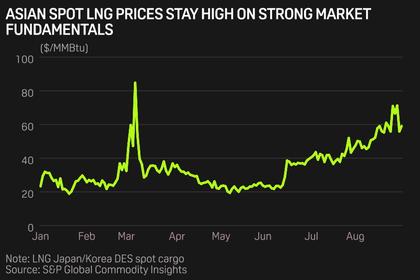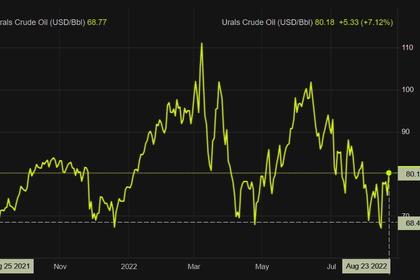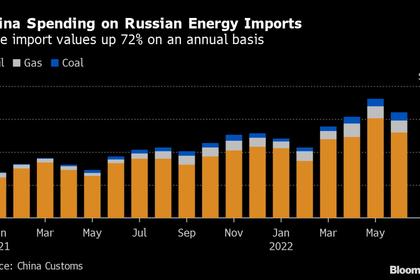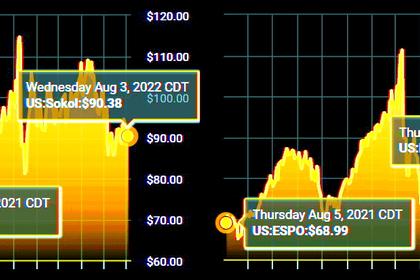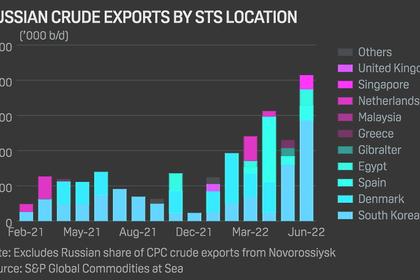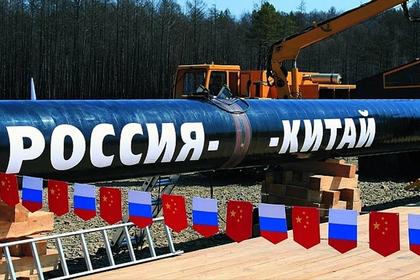
RUSSIA, CHINA ENERGY COOPERATION
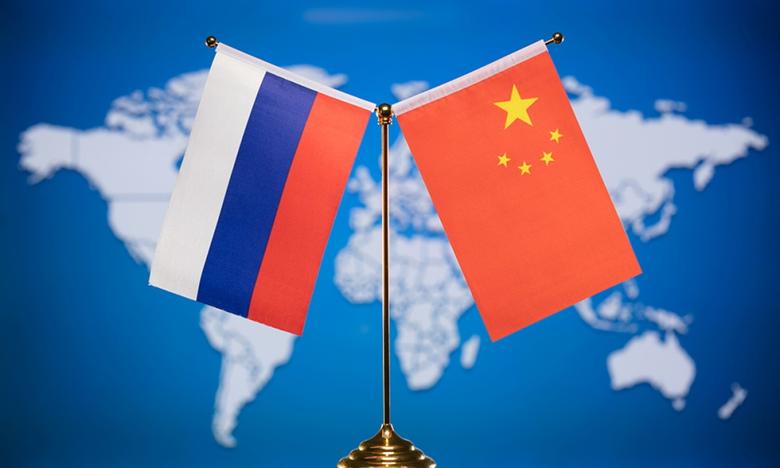
PLATTS - 14 Sep 2022 - Further expanding energy cooperation is set to be high up the agenda when Russian President Vladimir Putin and his Chinese counterpart Xi Jinping meet in Uzbekistan Sept. 15-16, given Russia's urgent need to find new destinations for its oil and gas exports as Western sanctions close off its previous markets.
This year has already seen Russia-China energy cooperation increase significantly. Oil and gas deliveries to China have risen since Russia's invasion began in February, and new supply and infrastructure deals were signed a few weeks before Russia's invasion was launched.
S&P Global Commodity Insights estimates that China's crude imports from Russia averaged 1.82 million b/d in January-July, 6.4% higher than in the same period of 2021.
China has been happy to take advantage of the sizeable discounts on Russian oil that have opened up following Europe's move to phase out Russian imports.
Platts assessed Russia's key crude grade Urals at $69.32/b on Sept. 13, according to S&P Global data, a sizeable discount to benchmark Dated Brent at $91.45/b. Prior to the invasion of Ukraine Urals was trading at a discount of around $10/b to Dated Brent.
Export limitations
However, Russia's ability to redirect exports East is threatened by strong market competition, China's interest in supply diversity, concerns over the coronavirus pandemic's impact on Chinese demand, as well as Russia's limited export capacity in that direction.
S&P Global forecasts China's oil demand will average 15.1 million b/d in 2022, a year on year contraction of 305,000 b/d, before recovering 485,000 b/d in 2023.
China will continue to buy Russian crude and perhaps some products, director of the gas research and China energy programs at the Oxford Institute for Energy Studies, Michal Meidan said.
"It will certainly buy crude to the extent that it is discounted, but may be reluctant to displace large volumes of oil from other suppliers and massively increase its dependence on Russia," she said.
The origin of Chinese imports saw some changes in August, reflecting competition for market share and China's interest in supply diversity.
Crude imports from the former Soviet Union declined 13% on month to 1.8 million b/d, while crude purchases from the Middle East, Africa and Malaysia grew.
Malaysia exports Malaysian Blend -- re-blended Iranian and Venezuelan grades.
"This means that China has been consistently increasing appetite of crudes from those two countries indirectly, as expected since they have been putting down crude prices to compete against the Russian offerings," S&P Global Commodity Insights said.
In addition, export capacity constraints mean that Russia is not able to redirect all oil volumes that traditionally went to European markets to Asia.
S&P Global estimates that 3.5 million b/d of previous Russian oil exports to Europe will need to be rerouted by Feb. 5, 2023, of which two-thirds will be able to find new buyers.
There are also limits to Russia's ability to export oil products to China.
"It will be difficult for Russia to fully reroute product exports, leading to expectations for Russian refinery runs to fall further in 2023," S&P Global oil market analyst Rebeka Foley said.
Meidan said that China's large refining system and desire to be self-sufficient in oil products will limit demand for rerouted Russian volumes.
Russia's main crude export route to Asia is the East Siberia-Pacific Ocean oil pipeline. ESPO has a spur into China and runs to the Far Eastern port of Kozmino. Pipeline operator Transneft said that ESPO worked at its full 80 million mt/year, or around 1.6 million b/d, capacity in the first seven months of 2022.
Russia also plans to increase oil export capacity at Kozmino by over 7 million mt/year by October. This would be an increase of about 20% on Kozmino's current capacity of 36 million mt/year. Russia can increase export capacity at the port by returning to deliveries via rail from Skorovodino.
Russia also ships around a quarter of its deliveries to China under long-term contracts via Kazakhstan.
In the longer term, Russia is developing new oil and gas export infrastructure at ports along the Northern Sea Route. The route runs through Russian territorial waters in the Arctic and has shorter delivery times and lower costs, as well as less geopolitical risk than traditional routes.
Supply deals
In early February state-run oil giant Rosneft signed a 10-year supply deal with China's CNPC for supply of 100 million mt, or around 200,000 b/d, of crude. The deliveries will be shipped via Kazakhstan for refining at plants in northwest China.
At the same time Gazprom signed a 10 Bcm/year gas supply deal with CNPC. This adds to a 30-year supply contract for 38 Bcm/year between Gazprom and CNPC signed in 2014.
Shipments are carried out via the Power of Siberia pipeline, which was launched in December 2019.
Gazprom said Aug. 31 that supplies via the route were up 60% year on year in the first eight months of 2022. Gazprom's 2021 exports were an estimated 10.5Bcm, so if the 60% growth is maintained through 2022, the total number for this year will be around 17 Bcm.
Chinese companies are also seen as potential buyers for stakes in projects that Western companies are exiting due to sanctions.
They have increased their investments in Russian projects since 2014, when Russian companies' access to Western financing was restricted due to sanctions. Chinese companies already hold stakes in Russian projects including Novatek's Yamal LNG and Arctic LNG 2.
-----
Earlier:
